Volcano Islands
The Volcano Islands (火山列島, Kazan Rettō) or Iwo Islands (硫黄列島, Iō-rettō) are a group of three Japanese islands south of the Ogasawara Islands that belong to the municipality of Ogasawara, Tokyo Metropolis, Japan.[1][2] The islands are all active volcanoes lying atop an island arc that stretches south to the Marianas. They have an area of 32.55 square kilometres (12.57 sq mi), and a population of 380. The island of Iwo Jima in the Volcano Islands lies about 1,240 kilometres (770 mi) southeast of Miyazaki.[3]
| Native name: 火山列島 | |
|---|---|
Location in the Pacific | |
| Geography | |
| Location | Pacific Ocean |
| Coordinates | 24°46′N 141°18′E |
| Total islands | 3 |
| Area | 32.55 km2 (12.57 sq mi) |
| Administration | |
Japan | |
| Prefecture | Tokyo |
| Subprefecture | Ogasawara Subprefecture |
| Village | Ogasawara |
| Demographics | |
| Population | 380 (January 2008) |
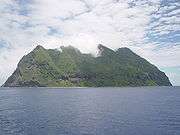
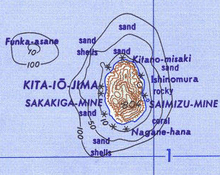
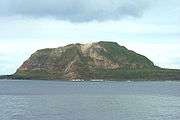
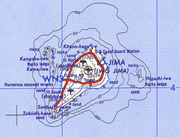


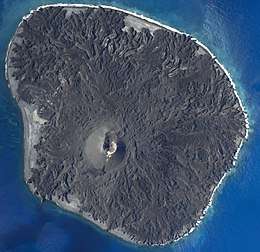
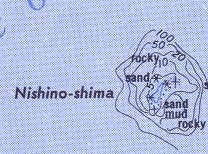
Geography
The Volcano Islands are:
- Kita Iwo Jima (北硫黄島, Kita-Iō-jima / Kita-Iō-tō, literally North Sulphur Island), 5.57 square kilometres (2.15 sq mi), 792 metres (2,598 ft) (Sakaki-ga-mine)
- Iwo Jima (硫黄島, Iō-jima / Iō-tō, literally Sulphur Island), 20.60 square kilometres (7.95 sq mi), 166 metres (545 ft) (Suribachi-yama)
- Minami Iwo Jima (南硫黄島, Minami-Iō-jima / Minami-Iō-tō, literally South Sulphur Island) 3.54 square kilometres (1.37 sq mi), 916 metres (3,005 ft)
Farther north but in the same volcanic arc is:
- Nishino-shima (西之島, literally Western Island), 38 metres (125 ft)[1]
There is a Japan Self-Defense Forces air base on Iwo Jima with a staff of 380. It is located in the village of Minami. Other than that, the islands are uninhabited.
 Satellite photo of the Volcano Islands (2004)
Satellite photo of the Volcano Islands (2004)
History
The first recorded sighting by Europeans was in October 1543 by Spanish navigator Bernardo de la Torre on board of carrack San Juan de Letrán when trying to return from Sarangani to New Spain.[4] Iwo Jima was charted as Sufre, the old Spanish term for sulphur.
The islands were uninhabited until 1889, when the two northern islands were settled by Japanese settlers from the Izu Islands. They were annexed by Japan in 1891.[1][2]
The population was about 1,100 in 1939, distributed among five settlements: Higashi, Minami, Nishi, Kita and Motoyama (meaning "East", "South", "West", "North" and "Mountain of Origin", or central mountain) on Iwo Jima; and two settlements on Kita Iwo Jima: Ishino-mura ("Ishino village"; Ishino is a surname) and Nishi-mura ("West village"). The municipal administration office was located in Higashi until 1940, when the municipality was integrated into the administration of Ogasawara, Tokyo.
Iwo Jima was the site of the Battle of Iwo Jima in World War II, and the island group came under the United States administration. The Volcano Islands were returned to Japanese administration in 1968.[1]
Ecology
The Volcano Islands have a subtropical climate. The islands are part of the Ogasawara subtropical moist forests ecoregion, and are home to a unique and diverse plants and animals, including many endemic species.
See also
References
- "火山列島" [Volcano Islands]. Nihon Daihyakka Zensho (Nipponika) (in Japanese). Tokyo: Shogakukan. 2013. OCLC 153301537. Archived from the original on August 25, 2007. Retrieved 2013-10-09.
- "火山列島" [Volcano Islands]. Nihon Rekishi Chimei Taikei (in Japanese). Tokyo: Shogakukan. 2013. OCLC 173191044. Archived from the original on August 25, 2007. Retrieved 2013-10-09.
- Google (1 February 2020). "Volcano Islands" (Map). Google Maps. Google. Retrieved 1 February 2020.
- Brand, Donald D. The Pacific Basin: A History of its Geographical Explorations The American Geographical Society (New York, 1967) p.123.
External links
